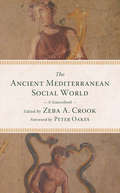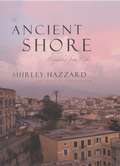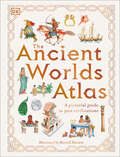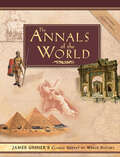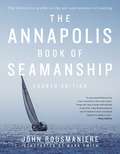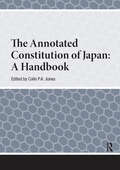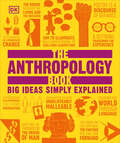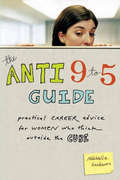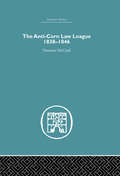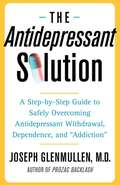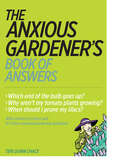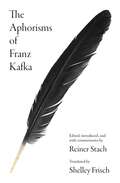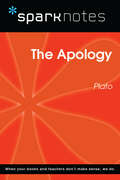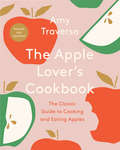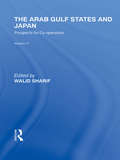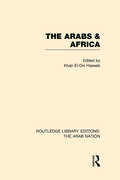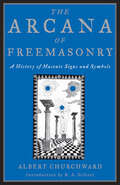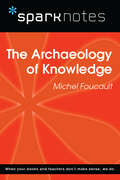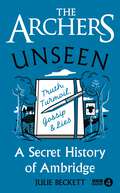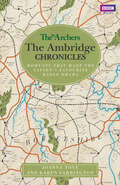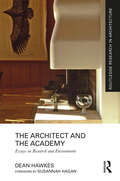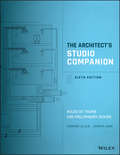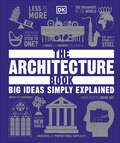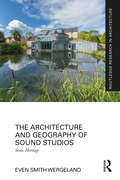- Table View
- List View
The Ancient Mediterranean Social World: A Sourcebook
by Zeba A. CrookWhat was the ancient world like? Ancient sources tell us a great deal about the cultural patterns and values that prevailed in the Mediterranean of the biblical periods:how they constructed identityhow they exercised control over groups, space, gender, and dresshow they thought of friendshiphow they participated in social and economic exchangehow ritual functioned and how kinship was constructedwhat healing practices, evil eye, and altered states of consciousness tell us about their scienceshow they talked about each other behind their backs, and whyThe Ancient Mediterranean Social World makes the rich social context of the ancient Mediterranean available to readers through succinct introduction of key ideas, thoughtful selection of translated primary sources, and extensive cataloging of relevant primary sources. Zeba Crook brings together leading scholars to write on twenty different topics, from patronage to gender to loyalty to evil eye. Each chapter opens with an introduction to the topic, offers a short list of secondary sources, and an extensive list of primary sources. The passages in each chapter reflect the vast array of sources roughly from Homer to Augustine, including epigraphical, papyrological, literary, historical, philosophical, biblical, and dramatic texts.This authoritative volume serves as a ready reference for the novice and experienced scholar alike.Contributors:Alicia J. Batten, Giovanni B. Bazzana, Agnes Choi, Zeba A. Crook, John W. Daniels Jr., Dennis C. Duling, John H. Elliott, Amy Marie Fisher, Mischa Hooker, Emil A. Kramer, Jason T. Lamoreaux, Dietmar Neufeld, Jerome H. Neyrey, SJ, Douglas E. Oakman, Ronald D. Roberts, Richard L. Rohrbaugh, Colleen Shantz, Gary Stansell, Eric C. Stewart, Erin K. Vearncombe, and Ritva H. Williams.
The Ancient Shore: Dispatches from Naples
by Shirley Hazzard Francis SteegmullerBorn in Australia, Shirley Hazzard first moved to Naples as a young woman in the 1950s to take up a job with the United Nations. It was the beginning of a long love affair with the city. The Ancient Shore collects the best of Hazzard’s writings on Naples, along with a classic New Yorker essay by her late husband, Francis Steegmuller. For the pair, both insatiable readers, the Naples of Pliny, Gibbon, and Auden is constantly alive to them in the present.With Hazzard as our guide, we encounter Henry James, Oscar Wilde, and of course Goethe, but Hazzard’s concern is primarily with the Naples of our own time—often violently unforgiving to innocent tourists, but able to transport the visitor who attends patiently to its rhythms and history. A town shadowed by both the symbol and the reality of Vesuvius can never fail to acknowledge the essential precariousness of life—nor, as the lover of Naples discovers, the human compassion, generosity, and friendship that are necessary to sustain it.Beautifully illustrated by photographs from such masters as Henri Cartier-Bresson and Herbert List, The Ancient Shore is a lyrical letter to a lifelong love: honest and clear-eyed, yet still fervently, endlessly enchanted.“Much larger than all its parts, this book does full justice to a place, and a time, where ‘nothing was pristine, except the light.’”—Bookforum“Deep in the spell of Italy, Hazzard parses the difference between visiting and living and working in a foreign country. She writes with enormous eloquence and passion of the beauty of getting lost in a place.”—Susan Slater Reynolds, Los Angeles Times“The two voices join in exquisite harmony. . . . A lovely book.”—Booklist, starred review
The Ancient Worlds Atlas (DK Pictorial Atlases)
by DKFrom the first cities of Sumer to the empire of the Incas, travel around the world and through 5,000 years of history in this illustrated guide to see where and how ancient peoples lived.From North America to New Zealand, this book takes you on a trip around the world and through history to visit ancient cities and empires, showing who lived where and explaining the unique features of each civilization.The Ancient Worlds Atlas is a pictorial guide to past civilizations, covering big history topics for curious kids aged 9-12 years. What was it like to live in the crowded city of Rome? Why did the Egyptians build pyramids? When did Samurai warriors first ride into battle? How did sailors first navigate the Pacific Ocean? Which Chinese emperor has a palace with 1,000 bedrooms? Find out the answers to these fascinating questions and much more in this lavishly illustrated guide to past civilizations. This fascinating children&’s book about ancient civilizations contains: - A visual guide to where our forebears lived, putting their lifestyles into context of where they lived and at what time.- An engaging, fact-packed, and educational book for children - especially those interested in history, ethnography, archaeology, and classics.- A timeline at the end of the book which traces the major events, battles, people, and inventions covered in the guide.- A stunning, retro illustration style combined with modern fonts that creates a fun and unique approach to this topic.Russell Barnett&’s hand-drawn illustrations literally put the past on map, showing where and why the world&’s great cities grew and how archaeological evidence has provided clues to the past. With stunning illustrations throughout, this large format book makes an appealing gift for young historians that will take pride of place on any bookshelf.
The Anglo-American Conception of the Rule of Law (Palgrave Studies in Classical Liberalism)
by Nicholas Capaldi Nadia E. NedzelThis book offers a multidisciplinary account of the 'rule of law' as a central pillar of the classical liberal tradition. The authors analyze the original meaning of this expression as first introduced by British jurist A. V. Dicey, before examining its subsequent elaboration by Leoni, Fuller, Hayek and Oakeshott. Addressing the main philosophical and legal aspects of the rule of law, this volume will appeal to all those engaged in law, political theory, philosophy, economics, business ethics, and public policy.
The Annals of the World
by James UssherConsidered not only a classic work of literature, but also esteemed for its preciseness and accuracy, The Annals of the World has not been published in the English language since the 17th century. Almost completely inaccessible to the public for three centuries, this book is a virtual historical encyclopedia with information and footnotes to history that otherwise would have been lost forever. Covering history from the beginning through the first century A.D., Ussher relates both famous accounts and little known events in the lives of the famous and infamous including pharaohs, Caesars, kings, conquerors, thieves, pirates, and murderers. He tells of the rise and fall of great and not-so-great nations and gives accounts of the events that shaped the world. As a historical work, Ussher's Annals of the Worldis a must-have for libraries of all sizes. Universities, public and private schools, professors, independent scholars, and pastors will find a treasure-trove of material previously unavailable. Containing many human interest stories from the original historical documents collected by Ussher, this is more than just a history book - it's a work of history. A Literary Classic: Important literary work that has been inaccessible in book form for over 300 years Translated into modern English for the first time from the original Latin text Traces world history from creation through A.D. 70 Over 10,500 footnotes from the original text have been updated to references from works in the Loeb Classical Library by Harvard Press Over 2,500 citations from the Bible and the Apocrypha Ussher's original citations have been checked against the latest textual scholarship 8 appendixes Find Out: Why was Julius Caesar kidnapped in 75 B.C.? Why did Alexander the Great burn his ships in 326 B.C.? What really happened when the sun "went backward" as a sign to Hezekiah? Discover the accurate chronology of earth history What does secular history say about the darkness at the Crucifixion?
The Annapolis Book of Seamanship: Fourth Edition
by Mark Smith John RousmaniereSince the publication of the widely hailed first edition in 1983, The Annapolis Book of Seamanship has set the standard by which other books on sailing are measured. Used throughout America as a textbook in sailing schools and Power Squadrons, The Annapolis Book of Seamanship thoroughly and clearly covers the fundamental and advanced skills of modern sailing. This edition of Annapolis is a major overhaul. Over half the book has been revised; old topics and features have been updated, and many new ones have been introduced. The design has been modernized, and many color illustrations have been added.As big and detailed as Annapolis is, the wealth of technical information (including dozens of step-by-step instructions) is presented here in a way that is uniquely readable; it's both useful and easy to use. This is because John Rousmaniere and artist Mark Smith bring to Annapolis decades of experience both as sailors and as professional communicators.Annapolis emphasizes the standard skills and proven methods that eliminate error and confusion, ensure security in emergencies, and allow every sailor more time for enjoyment on the water. Much has changed on the water since 1983 when this book was originally published. Black buoys are now green, the Global Positioning Satellite navigation system (GPS) is almost universally used, new types of anchors and sails have appeared, safety skills and gear are vastly improved, many more women are commanding boats, and catamarans and trimarans are common where only monohulls used to sail.But for all these modern developments, the basic skills and spirit of sailing have not changed at all. Sail trimming, keeping up steerageway, maintaining the dead reckoning plot, heaving-to -- these fundamentals are as important now as ever and receive much attention here. Among the innovations in this edition are:* Basic skills in early chapters: Fundamental sailing and boat-handling skills and gear, which are introduced in chapters 1, 2, and 3.* "Hands On" segments: Three dozen special sections, each devoted to a particular seamanship problem and an expert solution.* More how-to tips: Additional rules of thumb that guide a crew quickly and successfully through seamanship problems.* New coverage of multihulls: Advice on evaluating, anchoring, and handling catamarans and trimarans under sail (including in storms).* More on emergencies: New material on emergencies, safety, and heavy-weather sailing, including a section on preparing a docked boat for a hurricane.* Equipment updates: Expanded coverage of the use and care of modern gear and hardware, including radar, GPS, rescue devices, and asymmetrical spinnakers.* Terminology: Full definition and illustration of major terms when they're first introduced, with alternative language provided in parentheses.* Gender: The use of feminine personal pronouns, which reflect the fact that more women are captaining and sailing boats than ever before.From navigation and seamanship to boat and gear maintenance, from pleasure cruising to heavy-weather sailing, here is the definitive, state-of-the-art guide that provides systematic step-by-step techniques to see you through every situation on deck and in the cockpit.
The Annotated Constitution of Japan: A Handbook (Handbooks on Japanese Studies)
by Colin P.A. JonesThe Annotated Constitution of Japan: A Handbook for the first time makes the entirety of Japan’s constitution accessible in English. The book consists of a historical and contextual overview of how the constitution came into being, followed by descriptions of each of its 103 articles; the meaning of the text, interpretive disputes, academic theories and leading cases arising under them. The book also points out the many subtle distinctions between the English version and the Japanese, some of which arose from the charter’s unique provenance. With contributors representing a broad range of expertise in various areas of Japanese law, the book is written to appeal to academics, students and general readers alike. It is intended to be the first port of call for anyone needing to understand the fundamentals of Japanese constitutional law, whether from the perspective of Japanese studies, comparative law, or political science, but unable to access the text and related literature available in Japanese. Key reference documents in English and Japanese are included as appendices for ease of reference.
The Anthropology Book: Big Ideas Simply Explained (DK Big Ideas)
by DKExplore and understand the key ideas and movements in anthropology—the study of human societies and cultures and how they work. What does it mean to be human? Why do we have rituals? How do family structures differ around the world, and why? The Anthropology Book answers questions like these and many, many more. Applying the Big Ideas series’ combination of authoritative, accessible text and bold graphics, The Anthropology Book introduces key concepts from different branches of the subject, such as cultural anthropology, ethnography, and biological anthropology, and explains how they have developed over the past century. The book explores the origins of human life and cultures, and how societies develop traditions, laws, and languages. Profiling renowned anthropologists, such as Claude Levi-Strauss and Margaret Mead, and covering topics as diverse as biology, medicine, war, sexuality, family roles, and kinship, The Anthropology Book is a fascinating, accessible introduction to the core principles of anthropological thought.
The Anti 9 to 5 Guide: Practical Career Advice for Women Who Think Outside the Cube
by Michelle GoodmanToday, lots of women would love to integrate their passion with their career and are seeking advice on how to do just that. Michelle Goodman, a self proclaimed, "wage-slave" has written a fun, reassuring, girlfriend-to-girlfriend guide on identifying your passion, transitioning out of that unfulfilling job, and doing it all in a smart, practical way. The Anti 9-to-5 Guide realizes that not every woman wants the corner office, in fact, some women don't want to be in an office at all. Today's women are non-traditionalists, do it yourself sort of girls who want to travel the world, take up knitting, frolic in the land of freelancing but want to do it all without going broke. The Anti 9-to-5 Guide provides readers with the resources you need to have it all and still have a place to sleep. Michelle suggests great tips for easing into the life you want. With an entire chapter devoted to pursuing your passion on the side, The Anti 9-to-5 Guide encourages us to tweak our current career path or head down a new one, and ultimately succeed.
The Anti-Corn Law League: 1838-1846
by Norman McCordAlthough the Anti-Corn Law league played a most important part in the politics of the 1840's, there is no modern study of its activities and organization. Based on several years work on the original sources, as well as papers belonging to George Wilson, President of the League for most of its life, this book sheds light on the internal history and organization of the League. Written from a political perspective, Dr McCord describes the origin, organization and activities of the League, together with its effect on the contemporary political scene, and as such, fills an important gap in our knowledge of the political history of early Victorian England. At the same time, the book provides an analysis of an unusually well-documented political pressure group, making it a most welcome addition to literature for historians and economic historians, as well as students of political science. This book was first published in 1958.
The Antidepressant Solution
by Joseph GlenmullenWith the FDA's warning that antidepressants may cause agitation, anxiety, hostility, and even violent or suicidal tendencies, these medications are at the forefront of national legal news. Harvard physician Joseph Glenmullen has led the charge to warn the public that antidepressants are overprescribed, underregulated, and, especially, misunderstood in their side and withdrawal effects. Now he offers a solution! More than twenty million Americans -- including over one million teens and children -- take one of today's popular antidepressants, such as Paxil, Zoloft, or Effexor. Dr. Glenmullen recognizes the many benefits of antidepressants and prescribes them to his patients, but he is also committed to warning the public of the dangers associated with overprescription. Dr. Glenmullen's last book, Prozac Backlash, sounded the alarm about possible dangers. The Antidepressant Solution provides the remedy. It is the first book to call attention to the drugs' catch-22: Although many people are ready to go off these drugs, they continue to take them because either the patient or the doctor mistakes antidepressant withdrawal for depressive relapse. The Antidepressant Solution offers an easy, step-by-step guide for patients and their doctors. Written by the premier authority in the field, The Antidepressant Solution is an invaluable book for all those concerned with going through the process -- from friends and family members to doctors and patients themselves.
The Anxious Gardener's Book of Answers
by Teri Dunn ChaceThe Anxious Gardener's Book of Answers identifies the 100 most common gardening mistakes and gives gardeners the techniques to prevent them. Or, if it's too late and they've already goofed, there are tips to fix the mistake. The book's 24 chapters tackle every kind of gardening disaster, whether it has to do with plants, tools and techniques, or general care and maintenance. Gardeners looking to prune their roses will learn to hold off until late winter to avoid damaging plant tissue. Gardeners that have allowed their mint to overgrow? Dunn advises pulling it out and replanting it in a container to control the root. Organized by common garden topics and designed to be easily dipped in and out of, The Anxious Gardener's Book of Answers offers nuggets of wisdom based on Teri Dunn Chace's years of hands-on gardening experience. Advice is humorously supported by Colleen Coover's delightful illustrations. This accessible guide will transform an anxious gardener into an informed, confident, successful gardener with a mistake-free garden
The Aphorisms of Franz Kafka
by Franz KafkaA splendid new translation of an extraordinary work of modern literature—featuring facing-page commentary by Kafka’s acclaimed biographerIn 1917 and 1918, Franz Kafka wrote a set of more than 100 aphorisms, known as the Zürau aphorisms, after the Bohemian village in which he composed them. Among the most mysterious of Kafka’s writings, they explore philosophical questions about truth, good and evil, and the spiritual and sensory world. This is the first annotated, bilingual volume of these extraordinary writings, which provide great insight into Kafka’s mind. Edited, introduced, and with commentaries by preeminent Kafka biographer and authority Reiner Stach, and freshly translated by Shelley Frisch, this beautiful volume presents each aphorism on its own page in English and the original German, with accessible and enlightening notes on facing pages.The most complex of Kafka’s writings, the aphorisms merge literary and analytical thinking and are radical in their ideas, original in their images and metaphors, and exceptionally condensed in their language. Offering up Kafka’s characteristically unsettling charms, the aphorisms at times put readers in unfamiliar, even inhospitable territory, which can then turn luminous: “I have never been in this place before: breathing works differently, and a star shines next to the sun, more dazzlingly still.”Above all, this volume reveals that these multifaceted gems aren’t far removed from Kafka’s novels and stories but are instead situated squarely within his cosmos—arguably at its very core. Long neglected by Kafka readers and scholars, his aphorisms have finally been given their full due here.
The Apology (SparkNotes Philosophy Guide)
by SparkNotesThe Apology (SparkNotes Philosophy Guide) Making the reading experience fun! SparkNotes Philosophy Guides are one-stop guides to the great works of philosophy–masterpieces that stand at the foundations of Western thought. Inside each Philosophy Guide you&’ll find insightful overviews of great philosophical works of the Western world.
The Apple Lover's Cookbook: Revised And Updated
by Amy TraversoWinner of the IACP Cookbook Award (Best American Cookbook) Finalist for the Julia Child First Book Award "The perfect apple primer." —Splendid Table The Apple Lover’s Cookbook is more than a recipe book. It’s a celebration of apples in all their incredible diversity, as well as an illustrated guide to 70 popular (and rare-but-worth-the-search) apple varieties. Each has its own complete biography with entries for best use, origin, availability, season, appearance, taste, and texture. Amy Traverso organizes these 70 varieties into four categories—firm-tart, tender-tart, firm-sweet, and tender-sweet—and includes a one-page cheat sheet that you can refer to when making any of her recipes. More than 100 scrumptious, easy-to-make recipes follow, offering the full range from breakfast dishes, appetizers, salads, soups, and entrees all the way to desserts. On the savory side, there’s a cider-braised brisket and a recipe for Sweet Potato–Apple Latkes. On the sweet side, Amy serves up crisps, cobblers, pies, and cakes, including Apple-Pear Cobbler, Cider Donut Muffins, and an Apple-Cranberry Slab Pie cut into squares to eat by hand. As bonuses, The Apple Lover’s Cookbook contains detailed notes on how to tell if an apple is fresh and guides to apple festivals, ciders, and products, as well as updated information about the best times and places to buy apples across the United States, making it easy to seek out and visit local orchards, whether you live in Vermont or California. First published a decade ago, now newly revised and updated, The Apple Lover’s Cookbook is your lifetime go-to book for apples.
The Arab Gulf States and Japan (Routledge Library Editions: Japan)
by Walid SharifDuring the 1970s and ‘80s economic relations between the Arab Gulf States and Japan grew enormously. Approximately 65% of Japan’s oil requirements were met from Arab Gulf resources. However, although Japanese imports of Arab oil comprise the major component of trade, Arab imports of Japanese goods are also increasing sharply. The seven Arab Gulf countries, represented by the Petroleum Information Committee accounted for 8% of Japan’s total exports. This book explores the various avenues of economic co-operation that have developed between Japan and the Gulf States both in energy and other areas. It considers the measures that have been taken to protect the security of oil supply. It reports Japan’s co-operation in the development of the petroleum industry in the Arab Gulf States. The book also examines the future prospects for economic, technological and political co-operation between Japan and the Arab Gulf States.
The Arabs and Africa: The Arab Nation) (Routledge Library Editions: The Arab Nation)
by Khair El-Din HaseebConcentrating on the past, present and future relations of the peoples of Africa and the Arab world this book examines interaction between Arab and African countries; Africa and the Arab-Israeli conflict; Dimensions of Afro-Arab Cooperation. The book concludes with an open discussion on the future of Afro-Arab relations.
The Arcana of Freemasonry: A History of Masonic Signs and Symbols
by Albert ChurchwardIn this illustrated volume, an expert in arcane symbolism traces Masonic history from Ancient Egypt to the twentieth century through more than one hundred symbols.The Freemasons have profoundly altered the course of history. Their belief in liberty and equality influenced both the French and American Revolutions, as evidenced in part by the symbols on our currency. In The Arcana of Freemasonry, first published in 1915, Albert Churchward weaves a tale of Masonry’s origins in ancient Egypt and its continuance through history—all told via Masonic symbols and symbolism.From Egyptian history and Mayan relief work through Greek mathematicians, philosophers, and metaphysicians, Churchward traces the development of the most basic symbols of Freemasonry. He also reveals the hidden symbolism found in the signs and tools of modern Freemasonry and helps readers find hidden meanings in all areas of life from art and architecture to geometry and poetry.
The Archaeology of Knowledge (SparkNotes Philosophy Guide)
by SparkNotesThe Archaeology of Knowledge (SparkNotes Philosophy Guide) Making the reading experience fun! SparkNotes Philosophy Guides are one-stop guides to the great works of philosophy–masterpieces that stand at the foundations of Western thought. Inside each Philosophy Guide you&’ll find insightful overviews of great philosophical works of the Western world.
The Archers Unseen: A secret history of Ambridge
by Julie BeckettBlossom Hill Cottage – a secluded place with a dark past. It’s where Peggy discovered her husband Jack was an alcoholic, and it’s also where Helen stabbed her husband Rob, desperate in the face of his manipulation and control.And on to stately pile Lower Loxley – the Pargetters are proud of their centuries-old heritage, but how did Elizabeth arrive there, after her own turbulent early years, at odds with her family?This knowing excavation of Ambridge delights in the follies and everyday mischief of the inhabitants of England’s most famous village. Location by location, via the Bull and the occasional barn, the narrator takes us behind closed doors and picks up on all sorts of whispers around money, births, deaths and marriages, and romance and sex (often in inappropriate places …)In this canny, in-world exploration of Britain’s best-loved soap, we see how every relationship, each personal triumph and disaster, and all the hopes and dreams of a community over the years are folded into the personal stories of the characters we know so well today.
The Archers: Moments that made the nation's favourite radio drama
by Karen Farrington Joanna ToyeThe Archers, like life, is made of moments: marriages and births, loves and losses, triumphs and disasters. It has been the soundtrack of our lives for over six decades, from stooking corn with Dan Archer in the 1950s to the tragic death of Nigel Pargetter in 2011.We know the characters of Ambridge – from much-loved Phil and Jill Archer and the irrepressible Grundys to wayward Brian Aldridge – like we know close friends. This book is their tribute.The Ambridge Chronicles relives some of the defining moments in The Archers history, delving into the rich archive of its scripts, to celebrate the highs and lows that have made the world’s longest running radio serial so treasured.
The Architect and the Academy: Essays on Research and Environment (Routledge Research in Architecture)
by Dean HawkesThis book presents an expansive overview of the development of architectural and environmental research, with authoritative essays spanning Dean Hawkes’ impressive 50-year academic career. The book considers the relationship between the technologies of the environment and wider historical and theoretical factors, with chapters on topics ranging from the origins of modern ‘building science’ in Renaissance England to technology and imagination in architecture. It includes numerous architectural examples from renowned architects such as Christopher Wren, Peter Zumthor, Alvar Aalto, Robert Venturi and Carlo Scarpa. Aimed at students, scholars, and researchers in architecture and beyond, this illustrated volume collates important and wide-ranging essays tracing the definition, scope and methodologies of architectural and environmental studies, with a foreword by Susannah Hagan.
The Architect's Studio Companion: Rules of Thumb for Preliminary Design
by Edward Allen Joseph IanoThe time-saving resource every architect needs The Architect's Studio Companion is a robust, user-friendly resource that keeps important information at your fingertips throughout the design process. It includes guidelines for the design of structure, environmental systems, parking, accessibility, and more. This new sixth edition has been fully updated with the latest model building codes for the U. S. and Canada, extensive new information on heating and cooling systems for buildings, and new structural systems, all in a form that facilitates rapid preliminary design. More than just a reference, this book is a true companion that no practicing architect or student should be without. This book provides quick access to guidelines for systems that affect the form and spatial organization of buildings and allows this information to be incorporated into the earliest stages of building design. With it you can: Select, configure, and size structural systems Plan for building heating and cooling Incorporate passive systems and daylighting into your design Design for parking and meet code-related life-safety and accessibility requirements Relying on straightforward diagrams and clear written explanations, the designer can lay out the fundamental systems of a building in a matter of minutes--without getting hung up on complicated technical concepts. By introducing building systems into the early stages of design, the need for later revisions or redesign is reduced, and projects stay on time and on budget. The Architect's Studio Companion is the time-saving tool that helps you bring it all together from the beginning.
The Architecture Book (DK Big Ideas)
by DKLearn about key concepts behind the world&’s most incredible buildings in The Architecture Book.Part of the fascinating Big Ideas series, this book tackles tricky topics and themes in a simple and easy to follow format. Learn about Architecture in this overview guide to the subject, great for novices looking to find out more and experts wishing to refresh their knowledge alike! The Architecture Book brings a fresh and vibrant take on the topic through eye-catching graphics and diagrams to immerse yourself in. This captivating book will broaden your understanding of Architecture, with:- A global scope, covering architecture from all over the world- Packed with facts, charts, timelines and graphs to help explain core concepts- A visual approach to big subjects with striking illustrations and graphics throughout- Easy to follow text makes topics accessible for people at any level of understandingThe Architecture Book is a captivating introduction to buildings and the ideas, and principles that make them key to the history and evolution of our built environment - aimed at adults with an interest in the subject and students wanting to gain more of an overview. Here you&’ll discover the most important ideas, technologies, and movements in the history of architecture and structural engineering, through exciting text and bold graphics.Your Architecture Questions, Simply ExplainedLearn about the evolution of construction, from ancient and classical architecture through Medieval, Gothic, and Renaissance buildings, Baroque and Rococo, to 19th-century emerging modernism and postmodernism and glittering skyscrapers. If you thought it was difficult to learn about buildings and the ideas behind them, The Architecture Book presents key information in an easy to follow layout. Explore architectural movements, styles and celebrated buildings from all over the world, and stunning religious structures from mosques to churches, stupas to pagodas and temples.The Big Ideas SeriesWith millions of copies sold worldwide, The Architecture Book is part of the award-winning Big Ideas series from DK. The series uses striking graphics along with engaging writing, making big topics easy to understand.
The Architecture and Geography of Sound Studios: Sonic Heritage (Routledge Research in Architecture)
by Even Smith WergelandThis is a book about sound studios, focusing on their architectural and geographical aspects. It explores how music is materialized under specific spatial and technological conditions and the myths associated with this process.Through ten in-depth studies, it examines the design, evolution and current function of sound studios amidst economic and technological shifts in the music industry. Traditional studios are in flux between the past and future. The industry, while steeped in romanticism and nostalgia, also embraces forward-driven pragmatism and an extensive reuse culture, encompassing heritage audio, building materials and existing buildings. A surprisingly diverse architectural heritage, the most significant feature is the host building, the framework around the studio capsule. Many traditional studios adapt to digitalization with hybrid solutions, reflecting a shift toward smaller, more versatile spaces. In a time when recordings in theory can happen anywhere, destination studios must excel to attract clients, balancing historical legacies with diversification. Although they may be easy to deconstruct, many of the myths endure, sustaining ideas of landmark recordings, unique locations and distinct remnants of sonic heritage. Courtesy of their capacity to keep the past alive in the present, traditional sound studios are best described as museums that work.This book aims to reach scholars and students with an interest in history, theory and preservation, as well as practicing architects and architectural students who wish to find out more about the relationship between sound and space, acoustic design and retrofitting of historical buildings into specialized functions. It also aims to reach practicing musicians, producers, music students and music scholars.
